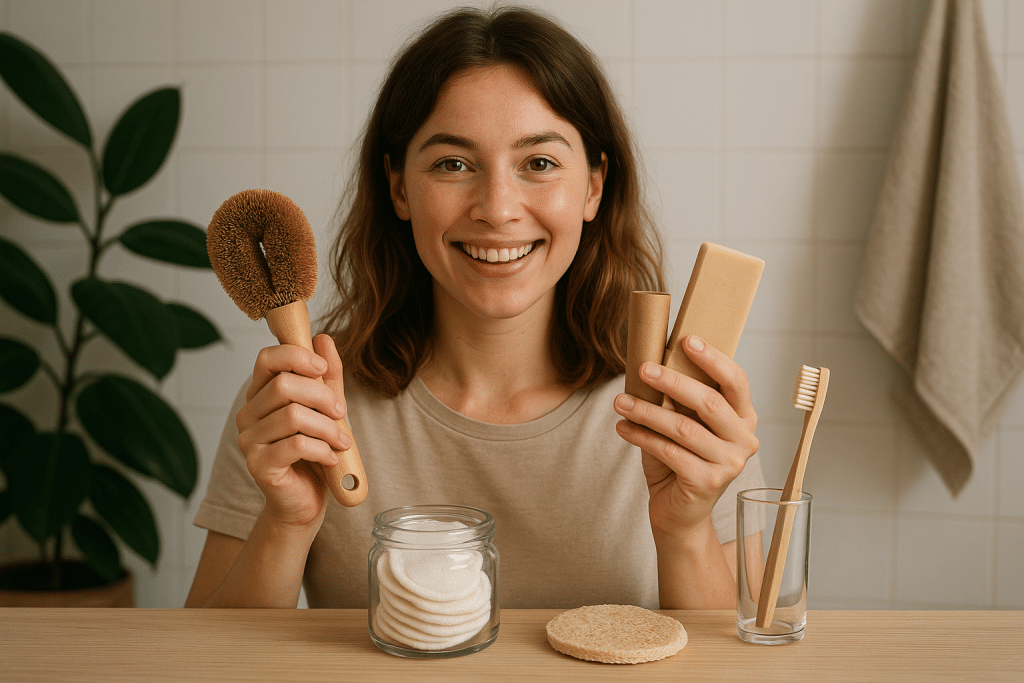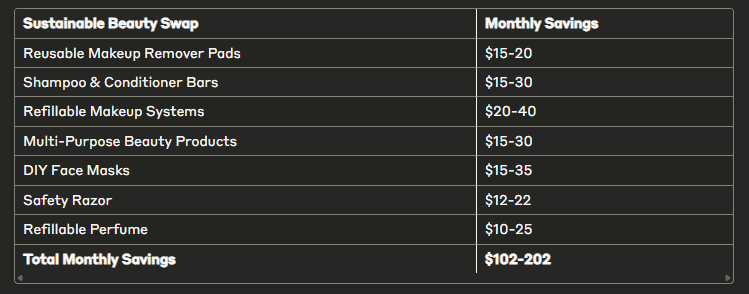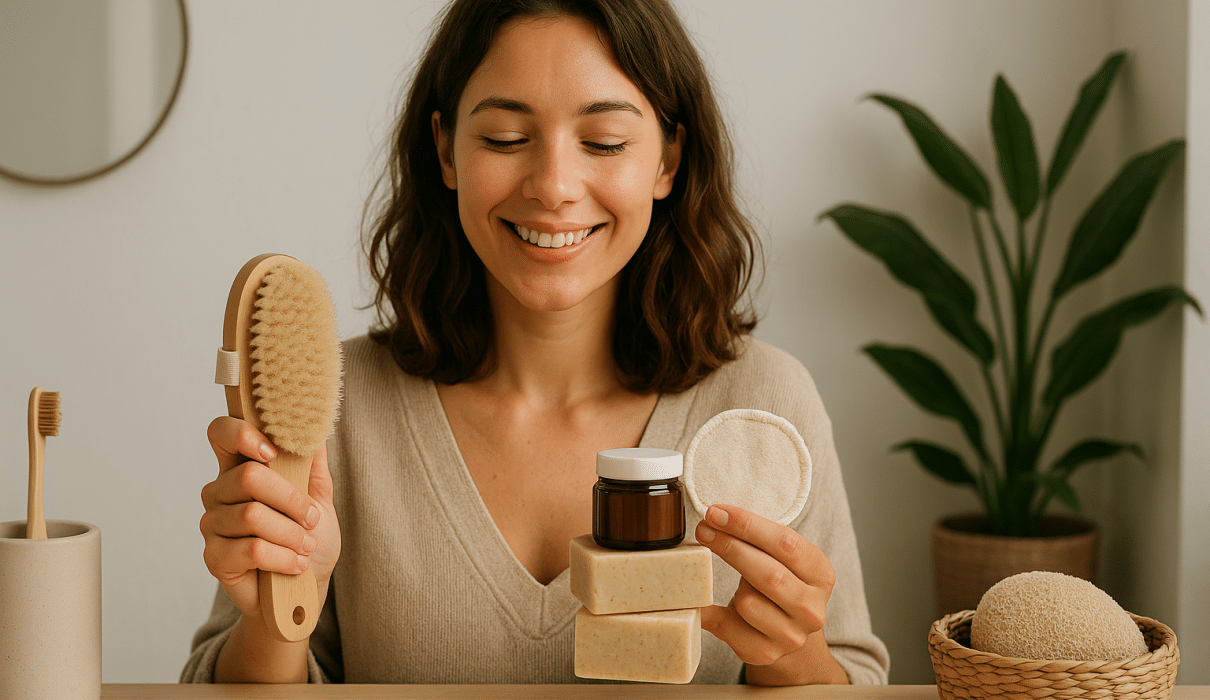Making sustainable beauty swaps isn’t just good for the planet—it’s great for your wallet too. As the beauty industry continues to evolve, eco-friendly alternatives are becoming more accessible and affordable than ever before. These smart sustainable beauty swaps can help you significantly reduce waste while saving serious money each month. In this comprehensive guide, we’ll explore seven game-changing alternatives that could put over $100 back in your pocket monthly while helping you build a more environmentally conscious beauty routine.
The Hidden Costs of Conventional Beauty Products
Before diving into our sustainable beauty swaps, let’s understand why conventional products can be so expensive in the long run. According to a study by SkinStore, the average woman spends approximately $313 per month on beauty products—that’s over $3,750 per year!
This hefty price tag comes with environmental costs too. The beauty industry produces over 120 billion packaging units annually, most of which ends up in landfills or oceans. By making strategic sustainable beauty swaps, you can address both financial and environmental concerns simultaneously.
7 Money-Saving Sustainable Beauty Swaps

1. Reusable Makeup Remover Pads
Traditional Option: Disposable cotton rounds or makeup wipes Monthly Cost: $15-20 (assuming one pack of wipes and one bag of cotton rounds) Environmental Impact: Single-use cotton products and wipes contribute to bathroom waste and often contain synthetic fibers that don’t break down.
Sustainable Swap: Washable, reusable makeup remover pads Initial Investment: $15-25 for a set of 20 reusable pads Monthly Savings: $15-20 after the first month Lifespan: 2-3 years with proper care
Reusable makeup remover pads made from bamboo, cotton, or microfiber can be used hundreds of times before needing replacement. Simply wet with water or your favorite makeup remover solution, use as normal, then toss in a mesh laundry bag to wash with your regular laundry.
“I was skeptical at first, but my reusable makeup pads actually remove makeup better than disposable cotton rounds! I’ve saved so much money over the past year.” — Sarah T., EcoChicGlam community member
For even more savings, pair these pads with a DIY makeup remover solution using ingredients like witch hazel, aloe vera, and jojoba oil.
2. Shampoo and Conditioner Bars
Traditional Option: Liquid shampoo and conditioner bottles Monthly Cost: $20-40 for mid-range products Environmental Impact: Plastic bottles contribute significantly to bathroom waste, with most ending in landfills despite being recyclable.
Sustainable Swap: Solid shampoo and conditioner bars Initial Investment: $10-15 per bar Monthly Savings: $15-30 Lifespan: One shampoo bar typically equals 2-3 bottles of liquid shampoo
Shampoo bars have come a long way in recent years and now cater to all hair types and concerns. They’re concentrated, travel-friendly, and free from plastic packaging. Brands like Ethique offer specialized formulations for different hair needs, from dry to oily and everything in between.
A quality shampoo bar can last up to 80 washes—equivalent to three 250ml bottles of liquid shampoo. To extend the life of your bars, store them in a soap dish that allows drainage and keeps them dry between uses.
3. Refillable Makeup Systems
Traditional Option: Single-use makeup products in plastic packaging Monthly Cost: $30-50 (assuming replacement of 1-2 items per month) Environmental Impact: Makeup packaging is often made of mixed materials that are difficult or impossible to recycle.
Sustainable Swap: Refillable makeup systems Initial Investment: $30-60 for compacts and initial products Monthly Savings: $20-40 Lifespan: Refillable compacts can last many years
Brands like Kjaer Weis, Elate Cosmetics, and even mainstream companies like MAC have embraced refillable systems. While the initial investment for the compact might be higher, refill pans are significantly cheaper than buying new products each time.
For example, a Kjaer Weis refillable foundation initially costs $70, but refills are just $40—saving you 42% on every refill while eliminating unnecessary packaging waste.
4. Multi-Purpose Beauty Products
Traditional Option: Single-purpose products (separate highlighter, blush, eyeshadow, etc.) Monthly Cost: $25-40 (replacing or adding one product monthly) Environmental Impact: More products mean more packaging waste and increased carbon footprint from manufacturing and shipping.
Sustainable Swap: Multi-purpose beauty products (like lip/cheek tints, multi-sticks) Initial Investment: $20-30 per product Monthly Savings: $15-30 Lifespan: Comparable to traditional products
Products like Ilia’s Multi-Stick or RMS Beauty’s Lip2Cheek serve multiple purposes, working as blush, lip color, and even eyeshadow. These versatile products not only reduce packaging waste but also streamline your routine and save precious bathroom space.
Check out our guide to minimalist beauty routines for more tips on streamlining your product collection.
5. DIY Face Masks and Treatments
Traditional Option: Pre-packaged face masks and treatments Monthly Cost: $20-40 for 4-8 single-use masks Environmental Impact: Individual packaging and non-recyclable materials create significant waste.
Sustainable Swap: Homemade masks using kitchen ingredients Initial Investment: $10-15 for base ingredients (which can be used for multiple applications) Monthly Savings: $15-35 Lifespan: Fresh ingredients make for fresh masks!
Using simple ingredients like honey, yogurt, avocado, and oatmeal, you can create effective treatments tailored to your skin’s needs. These natural ingredients often provide results comparable to expensive packaged alternatives without the preservatives or packaging waste.
Our popular post on DIY face masks from kitchen ingredients offers several recipes to get you started.
6. Safety Razor
Traditional Option: Plastic disposable razors Monthly Cost: $15-25 Environmental Impact: Plastic razors are rarely recyclable and contribute millions of pounds of plastic to landfills annually.
Sustainable Swap: Stainless steel safety razor Initial Investment: $30-50 Monthly Savings: $12-22 (cost of replacement blades is minimal) Lifespan: Decades with proper care; blades cost pennies each
A quality safety razor might seem expensive initially, but replacement blades cost as little as 10-20 cents each, compared to $3-5 for cartridge refills. With proper technique (check our guide to safety razor shaving), many users also report less irritation and ingrown hairs.
As a bonus, the stainless steel construction is virtually indestructible, making this a once-in-a-lifetime purchase that can actually become a cherished item in your sustainable beauty collection.
7. Refillable Perfume Systems
Traditional Option: Designer fragrance bottles Monthly Cost: $15-30 (amortized cost of $80-180 bottles purchased several times yearly) Environmental Impact: Perfume bottles often contain non-recyclable mixed materials (glass, plastic, metal).
Sustainable Swap: Refillable perfume systems Initial Investment: $30-50 for a refillable atomizer Monthly Savings: $10-25 Lifespan: Indefinite with proper care
Companies like Le Labo and By Rosie Jane offer refill programs that significantly reduce costs. Some department stores also offer perfume refill services at a discount. Alternatively, invest in a beautiful refillable travel atomizer and purchase larger bottles of your favorite scent for substantial savings per milliliter.
Monthly Savings Breakdown
Here’s how these sustainable beauty swaps add up to $100+ in monthly savings:

Beyond Financial Savings: Additional Benefits
These sustainable beauty swaps offer benefits beyond just monetary savings:
- Reduced environmental impact: Less waste, fewer resources consumed
- Higher quality products: Sustainable options are often made with better ingredients
- Simplified routine: Fewer products means less clutter and decision fatigue
- Better ingredient transparency: Eco-conscious brands typically provide clearer information about what’s in their products
- Supporting ethical companies: Your dollars go to businesses aligned with your values
According to a report by McKinsey, consumers are increasingly willing to pay more for sustainability. However, as our breakdown shows, being eco-conscious doesn’t have to come with a higher price tag—in fact, it often leads to significant savings.
Making the Transition to Sustainable Beauty
For a smooth transition to these sustainable beauty swaps:
- Start gradually: Replace items as they run out rather than all at once
- Research thoroughly: Read reviews and find the sustainable alternatives that will work best for your specific needs
- Calculate long-term costs: Look beyond the initial investment to see the true savings
- Share your experience: Tell friends about your sustainable beauty journey and the money you’re saving
- Be patient: Some sustainable swaps may require an adjustment period as you learn new techniques
FAQs About Sustainable Beauty Swaps
Are sustainable beauty products as effective as conventional ones?
Many sustainable beauty products perform just as well as—if not better than—conventional alternatives. The quality of sustainable beauty products has improved dramatically in recent years. Read reviews and potentially start with sample sizes when available to find what works for you.
Won’t I spend more initially when making these swaps?
While some sustainable beauty swaps require a higher upfront investment, you’ll typically recoup those costs within 1-3 months, after which you’ll start saving significantly. Think of it as an investment that pays dividends monthly.
How do I know if a product is genuinely sustainable and not just “greenwashing”?
Look for specific certifications (like USDA Organic, Leaping Bunny, or B Corp), transparent ingredient lists, and clear information about packaging materials and end-of-life disposal. We have a comprehensive guide to identifying greenwashing on our site.
Can I make these sustainable beauty swaps if I have sensitive skin?
Absolutely! Many people with sensitive skin actually find that simpler, more natural products cause fewer reactions. Start with patch tests, and remember that natural doesn’t automatically mean hypoallergenic—ingredient awareness is still important.
Where can I recycle beauty packaging that I already have?
Programs like TerraCycle’s Beauty Products Recycling Program accept hard-to-recycle beauty packaging. Some brands also have their own take-back programs—check manufacturer websites for details.
Join the Sustainable Beauty Movement
Making these sustainable beauty swaps isn’t just about saving money or reducing waste—it’s about being part of a growing movement toward more conscious consumption. Every bottle not purchased and every piece of packaging avoided represents a small but significant step toward a more sustainable beauty industry.
At EcoChicGlam, we’re committed to helping you navigate the world of sustainable beauty with honest reviews, practical advice, and supportive community. We’d love to hear about your own sustainable beauty journey!
Ready to start saving money and the planet? Begin with just one swap from this list and track your savings. Share your experience with us on Instagram or TikTok using #SustainableBeautySwaps.
What sustainable beauty swap will you try first? Let us know in the comments below!
Disclaimer: Individual savings may vary based on previous spending habits, product choices, and usage patterns. The estimates provided are based on average consumer spending on conventional beauty products.

